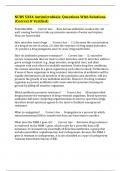Microbia - Study guides, Class notes & Summaries
Looking for the best study guides, study notes and summaries about Microbia? On this page you'll find 1425 study documents about Microbia.
Page 4 out of 1.425 results
Sort by
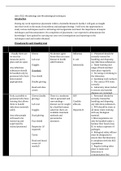
-
Unit 17CD - Aseptic Techniques and Factors Controlling Microbial Growth.
- Essay • 22 pages • 2023
-
- $11.79
- 1x sold
- + learn more
This is my Unit 17CD assignment. I spent lots of time and effort on this and have achieved a DISTNICTION from this. If you have any questions, enquires or need some assistance please feel free to send me a message. Good luck with your assignment!
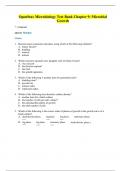
-
OpenStax Microbiology Test Bank Chapter 9: Microbial Growth
- Exam (elaborations) • 13 pages • 2024
- Available in package deal
-
- $12.50
- + learn more
OpenStax Microbiology Test Bank Chapter 9: Microbial Growth * = Correct answer Multiple Choice 1. Bacteria most commonly reproduce using which of the following methods? A. binary fission* B. budding C. meiosis D. mitosis 2. Which structure separates new daughter cells in binary fission? A. the crescent B. the division septum* C. the FtsZ D. the spindle apparatus 3. Which of the following is another term for generation time? A. doubling time* B. growth rate C. mitotic index ...
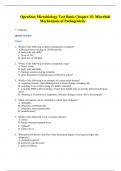
-
OpenStax Microbiology Test Bank Chapter 15: Microbial Mechanisms of Pathogenicity
- Exam (elaborations) • 16 pages • 2024
- Available in package deal
-
- $13.00
- + learn more
OpenStax Microbiology Test Bank Chapter 15: Microbial Mechanisms of Pathogenicity * = Correct answer Multiple Choice 1. Which of the following would be considered a symptom? A. blood pressure reading of 150/90 mm Hg B. body ache and chills* C. fever of 39 C D. heart rate of 120 bpm 2. Which of the following would be considered a sign? A. blurry vision B. body ache and chills C. burning sensation during urination D. gross hematuria (visible presence of blood in urine)* 3. W...
ANTIMICROBIAL GUIDELINES Third Edition 2024
NURS 5334 Antimicrobials: Questions With Solutions (Correct & Verified)
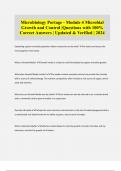
-
Microbiology Portage - Module 4 Microbial Growth and Control |Questions with 100% Correct Answers | Updated & Verified | 2024
- Exam (elaborations) • 18 pages • 2024
-
- $9.99
- + learn more
Expanding a given microbial population allows researchers to do what? to detect and assess the microorganism more easily What is Growth Media? Growth media is a liquid or solid formulated to support microbial growth. What does Growth Media contain? The media contains essential nutrients to provide the microbe with a source of carbon/energy. The nutrient composition often includes a rich source of sugars, amino acids and vitamins. What else can Growth Media also be called? Such media can al...
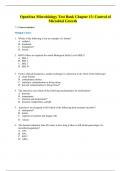
-
OpenStax Microbiology Test Bank Chapter 13: Control of Microbial Growth
- Exam (elaborations) • 13 pages • 2024
- Available in package deal
-
- $12.50
- + learn more
OpenStax Microbiology Test Bank Chapter 13: Control of Microbial Growth * = Correct answer Multiple Choice 1. Which of the following is not an example of a fomite? A. catheter B. doorknob C. mosquitoes* D. towels 2. HEPA filters are required for which Biological Safety Level (BSL)? A. BSL 1 B. BSL 2 C. BSL 3 D. BSL 4* 3. From a clinical perspective, aseptic technique is carried out to do which of the following? A. clean fomites B. contaminate fomites C. introduce co...
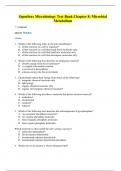
-
OpenStax Microbiology Test Bank Chapter 8: Microbial Metabolism
- Exam (elaborations) • 12 pages • 2024
- Available in package deal
-
- $16.50
- + learn more
OpenStax Microbiology Test Bank Chapter 8: Microbial Metabolism * = Correct answer Multiple Choice 1. Which of the following refers to the term metabolism? A. all the reactions in a cell or organism* B. all the reactions in a cell that break down molecules only C. all the reactions in a cell that build new molecules only D. all the reactions in a cell that decompose molecules only 2. Which of the following best describes an endergonic reaction? A. absorbs energy from the environment*...
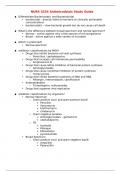
-
NURS 5334 Antimicrobials Study Guide
- Exam (elaborations) • 11 pages • 2023
- Available in package deal
-
- $7.99
- + learn more
NURS 5334 Antimicrobials Study Guide ▪ Differentiate Bacteriostatic and Bacterialcidal. • bactericidal – directly lethal to bacteria at clinically achievable concentrations • bacteriostatic – slow bacterial growth but do not cause cell death

-
PC707 Pharmacology Module 2 Infection Antimicrobials Exam
- Exam (elaborations) • 26 pages • 2024
- Available in package deal
-
- $12.49
- + learn more
PC707 Pharmacology Module 2 Infection Antimicrobials Exam ANTIMYCOBACTERIALS & ANTITUBERCULAR Patient Education - Answer ️️ -●Pt adherence crucial d/t long therapy ●Encourage good nutrition, & exercise. ●GI upset common first few weeks of therapy. ●Don't D/C medication if minor adverse effects. ●Take on empty stomach to ↑ absorption. ●Inform if epigastric distress or N occurs can take entire drug protocol w/meals or hour of dosing can be changed. ●Administration wi...

That summary you just bought made someone very happy. Also get paid weekly? Sell your study resources on Stuvia! Discover all about earning on Stuvia


